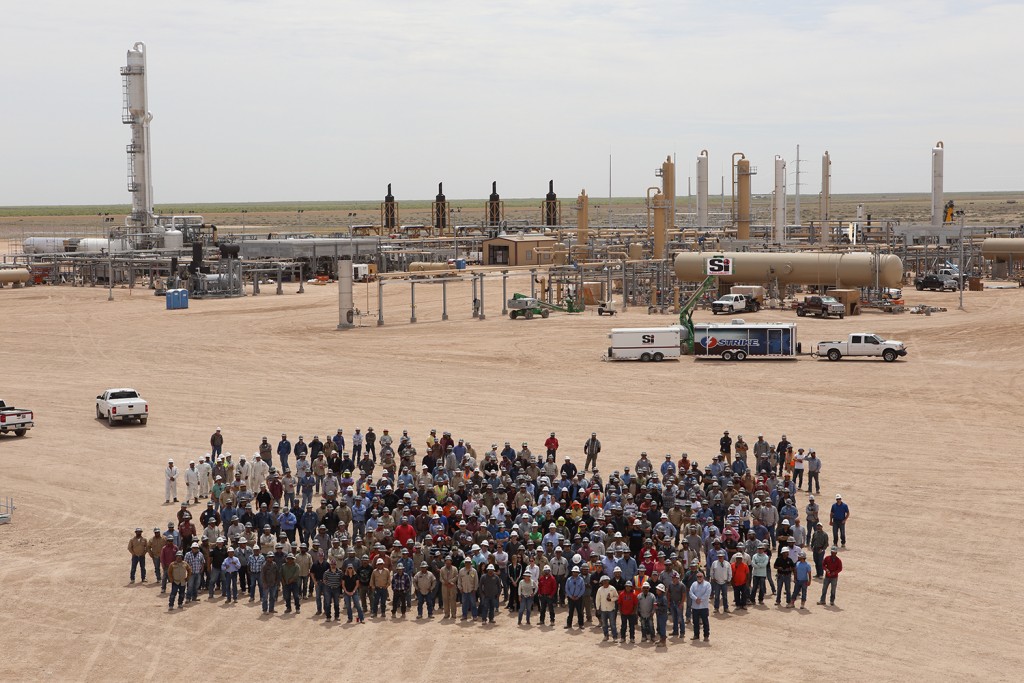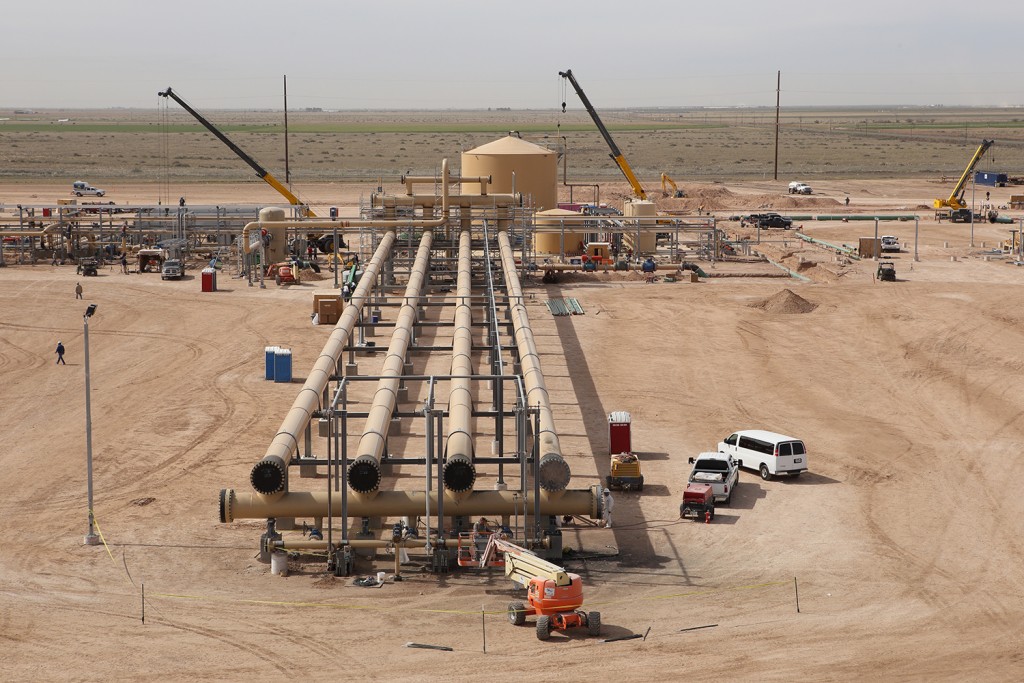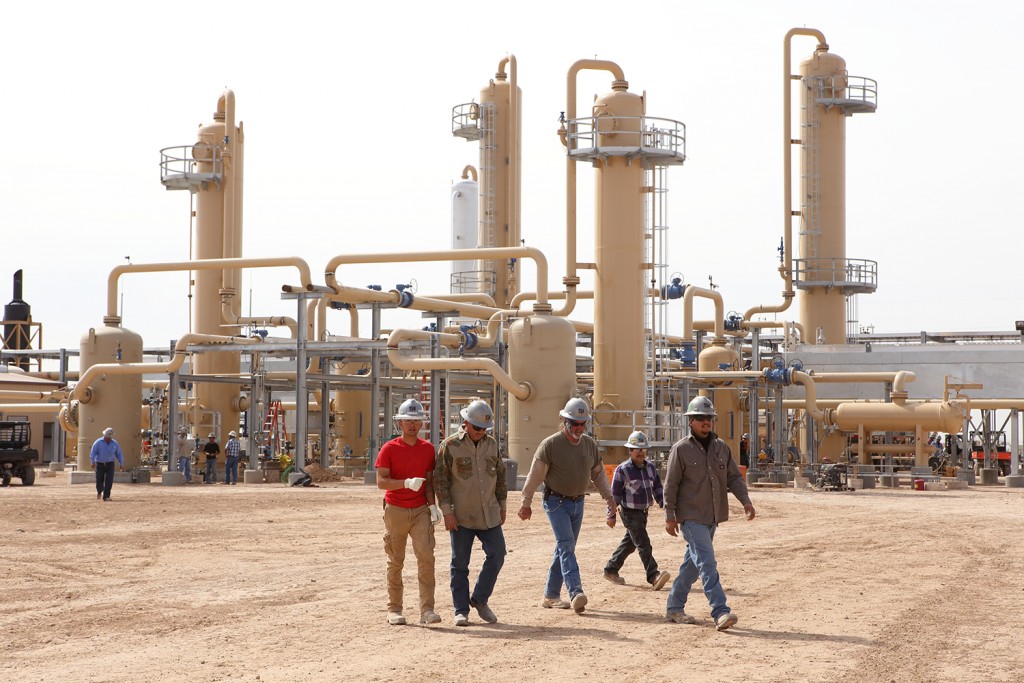by Paul Wiseman
In the Bible, when a fearful Jacob was about to be reacquainted with his brother, 20 years after stiffing him on his inheritance and other firstborn benefits, Jacob divided his people and herds into two cohorts. The idea apparently was that, however mad Esau was, he could only attack one group at a time, so the other group would have time to escape and live to fight another day.
It’s a lot like that today for the oilfield construction industry. For example, industry stalwart Saulsbury Industries, which began 49 years ago as a small company of electricians, now serves diverse industries such as nuclear power, power plants, and others beyond oil and gas. Basin newcomer IES Engineering, founded in 2002 in Bakersfield, Calif., is even more diverse, serving food and beverage, alternative energy, manufacturing, and water treatment along with oil and gas.
Even a smaller company like Odessa-based Pradon Trucking and Construction, as their name states, does more than one thing.
Saulsbury Industries
For Saulsbury, diversification began years ago but, said the company’s Senior Vice President of Business Development, Bubba Saulsbury, it’s more in earnest now. “We’ve been fairly diversified in years past. When the oil and gas would slow down we would migrate into some of these other industries. However, we always had a tendency to gravitate back to oil and gas when it picked up. We weren’t as disciplined as we needed to be, maintaining a presence in those industries.”
Since about 2013, the company has worked toward finding the right people to lead each of the divisions in order to have a full time focus on the other industries. This promotes regular, consistent growth regardless of what is happening in oil and gas. “We’ve said, ‘Here’s an industry, there’s a market, let’s hire a team of folks and them set them out on a course to be successful.’” Previously they would shuffle oil and gas employees in and out of the other endeavors, leading to gaps in production in nuclear, petrochemicals, and other divisions once the price of oil returned to a profitable level.
Part of what makes diversification possible is that the company started off by doing something other than drilling. “Unfortunately, a lot of companies out here, when you’re so tied to drilling… they can’t use that equipment, and/or their people or skillsets won’t transfer into any other industry. So when drilling shuts down they’re dead in the water,” Saulsbury said.
“Fortunately, we’ve chosen a business where we’ve not been too involved in the drilling/E&P side as much,” he continued. Even during the late ’90s downturn, when oil descended to $10 per barrel, Saulsbury was in better condition than those that relied on drilling.
In this downturn, they are better prepared to weather the storms because they are still family-owned and they have no debt. Growth and expansion have been organic, not fueled by debt-based purchases of other companies or by borrowing to buy land and equipment. It also allows them to make careful decisions for themselves. “We’re not answering to banks, we’re not answering to private equity, we’re not answering to Wall Street like the public companies do,” Saulsbury explained.
He continued, “Everything we do is with a long-term focus—we’re not just looking short-term.” He went on to say this philosophy has allowed the company to experience more growth without debt and its associated risks than others have managed to do with debt.
This is not to say that all is completely rosy. Even with Saulsbury Inc.’s fingers in so many pies, the oil business is still enough of a force that the downturn has cut the company’s revenues by 10-to-15 percent. And the current employment level of 2,600 is down about 1,000 from its peak in January of 2015, although most of those thousand were short-termers hired for specific projects. “Even with this downturn we’ve not downsized with what we would consider full time employees,” said Saulsbury. Less than one percent of full-time employees have been let go.
In order to obtain sustainable income the company has signed ongoing maintenance agreements with nuclear power plants. They also do pipeline construction. They are moving toward renewables such as solar battery storage. They have opened an office and a plant in LaPorte, on the Houston Ship Channel. They also have locations in Dallas, Houston, Port Arthur, Henderson, and Abilene, as well as in Baton Rouge (La.), Farmington (N.M.), and Denver.
Pradon Construction and Trucking
Having been through several downturns in the past doesn’t make it any easier the next time, said Don Pradon, who presides over the construction side of Pradon Construction and Trucking. “It never gets easy, no matter how many times you’ve done it,” he said. But, like Saulsbury, the company’s refusal to overextend its growth has helped it weather the tough times.
“We’ve had several chances to get really big over the years,” he recalled. “We’ve tried to stay at a steady growth rate that we thought we could maintain and still have a good handle on it.”
Don’s father, Pete, founded the company in the early 1960s with a couple of tractors and a work ethic that far exceeded any dawn-to-dusk limitations. Don Pradon noted that even though the company has grown greatly since then—adding the trucking side in 1972—that’s still the philosophy they live by. “We’ve tried to stay out of debt and maintain a fleet of good equipment and stay small enough to have the employees you want to have,” he continued.
They’ve kept many of those employees for decades because of the company’s family atmosphere. Approximately 200 employees are on the roll companywide, with about 40 of those on the construction side.
Longevity has been possible on the hiring side because, said Pradon, the company has stayed reasonably busy during the waves of down cycles over the years, so layoffs were limited. That loyalty to employees has been rewarded, in turn, by the employees staying on when boom times might let them make a couple of dollars an hour more down the road.
Speaking of longevity, Pradon Construction and Trucking is on its third generation of Pradons. Don and his brothers Darrel and Danny have run the company together for decades and now Don’s son, Barrett, has come aboard.
Barrett had worked for three years for a larger company that had implemented a wide range of computer and smartphone-based efficiencies—which he has now adapted for Pradon Construction and Trucking. Don admits to some resistance on his part to those changes and to using GPS-guided earthmoving equipment—but after seeing improvements in workflow and in accuracy, he’s now a believer.
Over the last two years, Pradon said, the company’s construction projects have gotten bigger in scale. “A location size used to be around 300-by-200-feet, now they’re 500-by-300-feet,” he said. “They’ve doubled in size; frac pits have gone from a small 200-by-200 size to maybe 800-by-800.”
This is largely because E&P companies now typically drill 3-to-5 wells off one pad instead of just one. Pradon also does dirt maintenance, such as roads, tank pads, and more. Five years ago the company opened a yard in Pecos, a location that has benefitted from the continued activity in the nearby Delaware Basin.
Pradon’s customer model began changing as early as the time of the 1980s bust when their previous customers—the Arcos, Texacos, and other majors of the world—either moved away or were bought out. Many of Pradon’s contacts at those companies moved on then to mid-size and smaller firms, maintaining their loyalty to Pradon.
“You follow these guys… some of them that I’ve known since the ’70s and ’80s, I still have contact with them these days,” he said. Some are still in the business and some have retired, but the relationships remain.
The scattering of those contacts effected a change from Pradon’s early days with just a few customers. As they spread out, the customer list went from a few large ones to many smaller ones, which is exactly what Don Pradon attributes to the company’s still being busy in this economy. He says, “We’ve really been blessed.”
IES Engineering
And then there was the company that decided to make its debut in the Basin during the worst days of the bust, in April of this year. Some may question the timing, but according to Joe Wilson, director of operations at Bakersfield-based IES Engineering, there were good reasons to move ahead.
“What has been attractive about the Permian Basin is its similarities to southern California oilfields that we’re used to—not necessarily the product in the ground, I understand there are differences there—but oil and gas has been right in the wheelhouse of what we’ve done. The majority of our work over the years has been in the oil and gas industry and in order to satisfy the need to expand, the best thing to do was to expand based on the skillset we’re good at.”
The company, founded in 2002, already had some clients in the Permian Basin. They had also done work in California for companies like Chevron and Oxy, both of whom have new office buildings in Midland.
Interestingly, the company’s first two projects have been related to natural gas instead of oil, but they look for those to open the doors to other work. At this writing, there is one employee in a small office in downtown Midland, but they are looking for land to place a yard and a shop, and expect to be hiring workers soon. Wilson said they expect to staff up by hiring locally while sending enough workers from Bakersfield to teach the new hires about the company philosophy and work ethic.
Their very first project involved engineering, which could be done long-distance, not requiring any crews in the Basin.
Wilson cited the advantages of moving to the area during a downtime—property is more affordable, good workers are available and the lines at restaurants are shorter.
Plus, business is getting harder and harder to do in California, while Texas—and the Permian Basin in particular—is still friendly to business, especially the oil business. And there is more oil activity here than anywhere in the United States.
Down the road—physically and figuratively—are also opportunities for IES to expand into renewables such as wind and solar, into food and beverages in Lubbock and Amarillo, and into other industries matching their skillset. According to Wilcon, “…our primary focus, and the easiest one for us to accomplish, is to start doing work in the oil and gas industry.”
Eventually they would also like to work in Southeast New Mexico, South Texas, and other areas in oil and gas, dairies, and more.
Following the company philosophy of moving forward in measured cadence, Wilson said they are glad to start with just a few projects, not wanting to “bite off more than we can chew” at first. They want to make sure any project they take on meets the company standards instead of being rushed to completion before staffing and facilities are in line.
Wilson said the company has found a warm welcome in the Permian Basin. “The reception has been top notch. Everybody has been welcoming, has been extremely courteous and professional,” he related. “[People] are taking time out of their day to hear what we have to talk about, and that speaks volumes as far as we’re concerned.”
He also noted that the downturn means people have more time to listen than might have been the case two years ago.
These three companies have several things in common: measured organic growth, private ownership, zero debt, and a clearly defined company philosophy/work ethic that creates loyalty among staff and clients alike, whether times are good or bad. While these things do not indemnify them from pain during hard times, it gives them the tools with which to survive and live to work another day.
Paul Wiseman is a freelance writer in Midland, TX.
You can huff and you can puff….
Oilfield graybeards all have one or more harrowing stories of how they narrowly escaped death, or injury in a blowout, or a major storm featuring flashes of lightning or Biblical-scale hailstones. These stories have always been better received among coworkers on a well site than among spouses and children at home, those who depend on and fear for the safety of the worker.
Not that they’re at all against a good story, but Red Dog Shelters VP of Business Development Marc Gilmour and the others have made it their goal to create a simple way for everyone to safely ride out storms and other dangers.
Gilmour says portability combined with stability is what sets this relatively new concept apart from the shelters available before the Big Dog became available in earlier this decade.
“You had permanent shelters that needed a concrete slab, or you had underground shelters,” said Gilmour. Underground shelters required heavy digging equipment and verification that it was safe to dig (no underground pipelines, etc.). When moving time came, it had to be dug up, then re-buried at the next site, all at great cost in dollars and hours. “There was nothing that was truly portable,” he said.
In 2012, a particular company approached Oscar Scott, P. E., a longtime veteran of oilfield safety engineering, about creating a more portable option that would still satisfy all safety requirements.
The result was a unit that uses aerodynamic principles similar to those of airplane wings to create a building that has no need of concrete pads or other kinds of external anchoring—one that actually holds more tightly to the ground as wind speed increases, up to 350 mph.
At first blush, it sounds backward to use lift mechanics to anchor a building but the secret is in a pair of tubes that open at the top of the building and connect to a chamber under the building. The curved top of the shelter causes winds to flow faster over the top, lowering pressure. On an airplane, that creates the lift needed for flight.
On a Red Dog shelter, the two tubes use that reduced pressure to create suction, pulling the unit more tightly to the chamber, keeping everything firmly on the ground.
From there, designers created a building that would be easy to transport—8.25 feet wide and 8.25 feet tall, very similar to a standard semi trailer. It weighs 38,000 pounds.
Functionality and comfort on site was a priority. Big Dogs can be used for meetings, offices, training, rapid cool-down, and other things for which a building is needed anyway. The buildings are heated and air-conditioned, and are safe from hazardous gases.
Severe weather text-alert system integration is included, along with a GPS unit in each shelter. At setup, the crew enters the GPS coordinates into the severe weather alert system—and all workers can enter the coordinates into their smart phone or other device. When dangerous weather approaches, anyone near the shelter will receive a text alert indicating that it’s time to dash to safety.
This all sounds good, but one might be interested to know if one of these buildings actually been through rough weather. Other than in tests by accrediting organizations, which they’ve passed with flying colors, there has been no direct hit as of yet—although, Gilmour reports, there have been some close calls.
“This year we’ve had a group in Mississippi that’s had to take cover multiple times,” Gilmour said. And in 2015, there were other rushes to shelter. Tornadoes, high winds, lightning, and hail are among the reasons for dashing to a Big Dog shelter.
With man-made impact also possible today, building entrances have a 6-point secure lock system that prevents entrance by any suspicious or unauthorized personnel.
While Red Dog sells a few units now, most of them are rented out. Gilmour says the busy season extends from March through October, when violent weather is most prevalent.
Market demand for the units was immediate and steady during those months. The company has built 120 units that are spread among approximately 25 clients, most of which are in the oil patch. Units are manufactured in Lubbock, at Scott Manufacturing.
The company is in the process of releasing the smaller Tow Dog unit, which they plan to market beyond the oil industry, to wind farms, manufacturing, the military, and others.
—Paul Wiseman













